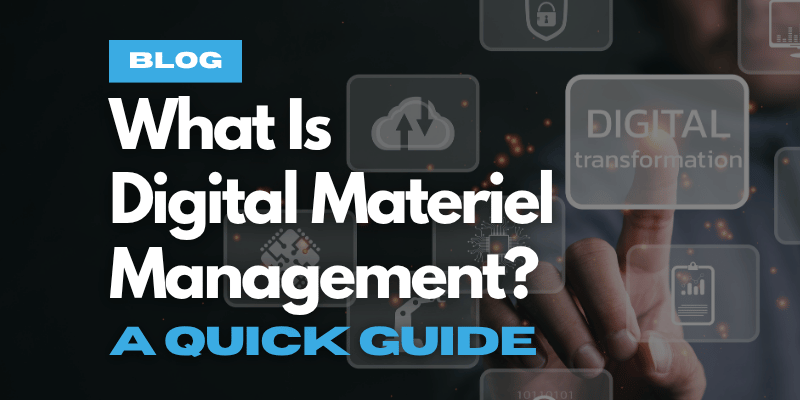2 min read
Digital Materiel Management: How USAF Brings a Digital Transformation
The United States Air Force (USAF) has long been at the forefront of technological innovation, and its adoption of digital materiel management...
4 min read
SPEC Innovations Team
:
5/29/25 8:00 AM

Digital Materiel Management (DMM) is a modern approach to managing the entire lifecycle of materiel, supplies, and systems through the principles and practices of digital engineering. By integrating digital tools, data, and advanced technologies, DMM enables organizations to streamline acquisition, logistics, sustainment, and modernization efforts. It is being rapidly adopted by organizations such as the United States Air Force (USAF) to improve efficiency, agility, and collaboration across the enterprise.
Contents of this guide:
The key characteristics of digital materiel management (DMM) systems revolve around automation, real-time visibility, and data integration. Here’s a concise breakdown of the most important traits:
Lifecycle Integration: DMM integrates digital methods across the materiel lifecycle, from invention and acquisition to sustainment and eventual retirement. This applies to both warfighting systems and mission support capabilities.
Digital Tools and Data: It replaces traditional, document-based processes with digital models, structured data, and advanced software systems. This shift supports real-time tracking, predictive analytics, and automation.
Collaboration and Transparency: DMM fosters collaboration between government, industry, and stakeholders by breaking down silos and enabling the sharing of models and data through secure, structured formats.
Accelerated Delivery: By leveraging digital methods, DMM aims to dramatically reduce the time required to develop, deploy, and sustain new capabilities, addressing the challenge of outpacing global competitors3.
Culture and Workforce: DMM is not just about technology; it requires a digital-first culture, workforce training, and new strategies to fully realize its benefits.
According to the Air Force Materiel Command (AFMC), the advancement of Digital Materiel Management (DMM) is being pursued through several key initiatives. Firstly, efforts are being made to structure and secure data, ensuring seamless sharing and effective decision-making. In parallel, the modernization of IT infrastructure is underway to support digital operations adequately. Access to digital tools and platforms is being enhanced for all personnel, enabling them to operate efficiently in a digital environment. Furthermore, there is a strong emphasis on instilling a digital-first culture across the entire organization. Lastly, developing and implementing digital strategies are focused on fostering continuous improvement throughout the command.
Although Digital Materiel Management is still a new concept, it's increasingly essential in industries where efficiency, traceability, and agility are competitive advantages. Here are practical applications:
Advanced Inventory Management: Utilizing AI, machine learning, RFID, and IoT for real-time tracking, demand forecasting, and process automation.
Unified Digital Platforms: Integrating supply chain, procurement, and logistics systems to enhance coordination and visibility.
Model-Based Systems Engineering: Employing digital models to define, simulate, and optimize requirements and processes throughout the lifecycle.
🚀 Keep Learning:
Digital Materiel Management delivers a range of strategic and operational advantages by leveraging digital technologies to optimize the lifecycle of materiels, supplies, and assets. Here are the key benefits, supported by recent implementations and expert analysis:
✅ Faster Capability Delivery: Shortens timelines for fielding new systems and upgrades, helping maintain a competitive edge.
✅ Increased Efficiency: Reduces manual errors, streamlines processes, and optimizes inventory and resource use.
✅ Enhanced Collaboration: Improves communication and coordination across departments, industry partners, and stakeholders.
✅ Better Decision-Making: Provides real-time, data-driven insights for proactive management and risk mitigation.
Innoslate is a cloud-native platform that offers a comprehensive suite of tools for digital materiel management, supporting the entire lifecycle of materiels from acquisition to disposal. Here’s how Innoslate can be leveraged for effective digital materiel management:
.jpg?width=539&height=404&name=Innoslate%20Digital%20Material%20Management%20Capabilities%20(1).jpg)
Defining and Tracking Requirements: Innoslate allows users to clearly define, document, and track material management requirements throughout a project’s lifecycle. This ensures all needs are traceable and reduces miscommunication and errors.
Traceability Matrix: Users can link process steps, requirements, and test cases to ensure comprehensive coverage and accountability across materiel management activities.
📖 Keep Learning: Ultimate Guide to Requirements Management
Modeling Logistics and Supply Chain Systems: Innoslate enables users to create detailed models of logistics and supply chain processes. These models can simulate various scenarios, enabling organizations to assess the impact of different strategies on material flow and inventory levels.
Discrete Event Simulation: The platform supports the simulation of resources, time, and assets, enabling users to estimate costs, optimize supply chain processes, and enhance decision-making.
Lifecycle Tracking: Innoslate provides tools to manage and track materiels through every phase, ensuring efficient use and minimizing lifecycle costs.
Inventory Management: The platform enables the tracking and management of inventory, helping to prevent production delays and optimize resource allocation.
Centralized Data Collection and Analysis: Innoslate’s integrated data management capabilities allow seamless collection, storage, and analysis of data from multiple sources. This real-time visibility into inventory levels and materiel conditions is crucial for informed decision-making.
System Integration: Innoslate can integrate with other systems and databases, ensuring all relevant information is available to stakeholders.
Collaborative Platform: Innoslate facilitates real-time collaboration among team members and stakeholders, allowing them to share information, provide updates, and work together on tasks. This enhances coordination and ensures alignment with material management strategies.
Project Management Dashboard: The dashboard provides visibility into project status, deadlines, and events, supporting effective planning and execution.
Risk Management Tools: Innoslate offers features for identifying, assessing, and mitigating risks in materiel supply and logistics, helping to prevent disruptions and ensure operational continuity.
Compliance and Audit Trails: The platform supports regulatory compliance by maintaining comprehensive audit trails and offering robust reporting capabilities.
Document Templates and Baselines: Users can create, baseline, and manage requirements documents, ensuring version control and easy tracking of changes.
Change Requests: Innoslate supports configuration management, enabling reviewers to request and track changes, which helps maintain up-to-date and accurate documentation.
Action Diagrams and Visual Tools: Innoslate provides visual modeling tools, including action diagrams, block definition diagrams, and physical I/O diagrams, to illustrate and analyze materiel management processes.
Reporting: The platform generates various reports, including entity definition reports, traceability matrices, and change reports, which support transparency and accountability.
Innoslate streamlines digital materiel management by providing an integrated environment for requirements management, system modeling, inventory tracking, collaboration, risk management, and compliance. Its robust features enable organizations to optimize supply chains, enhance communication, and ensure efficient and compliant material management throughout the lifecycle.
Get an expert to help you start implementing Digital Materiel Management. Contact us today to create a strategy.
Have questions about model-based systems engineering or requirements management? Talk to an expert and see how Innoslate can streamline your projects from start to finish.

2 min read
The United States Air Force (USAF) has long been at the forefront of technological innovation, and its adoption of digital materiel management...
A Data Management Plan (DMP) is a crucial digital engineering tool for systems and digital engineers, serving as a visual framework that organizes...
.png)
A 2 Step Approach to Digital Engineering SPEC Innovations takes a unique approach to digital engineering (DE). Step 1: We began by developing a...